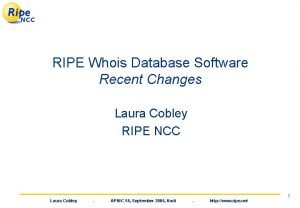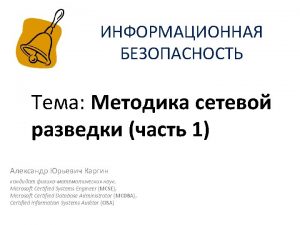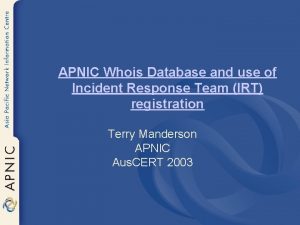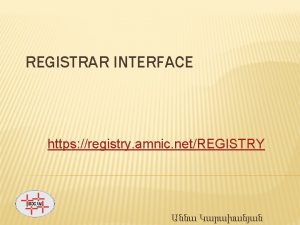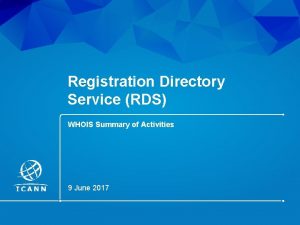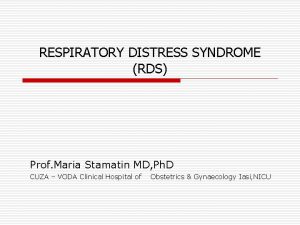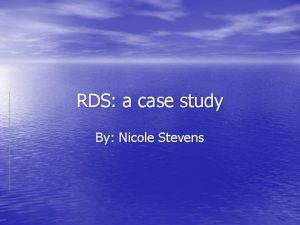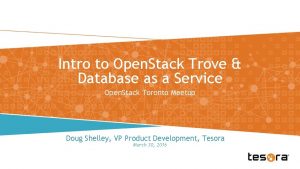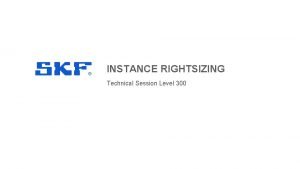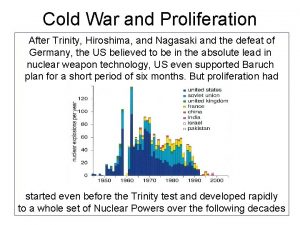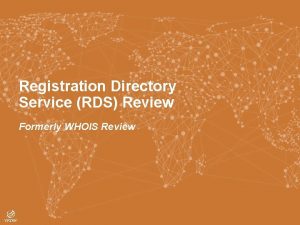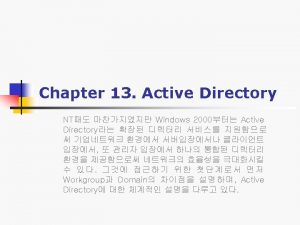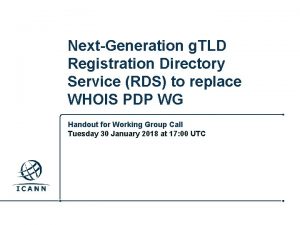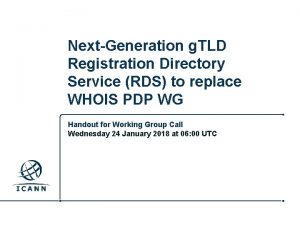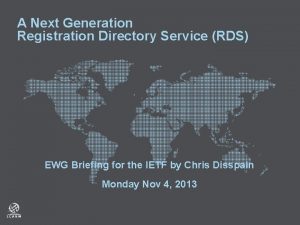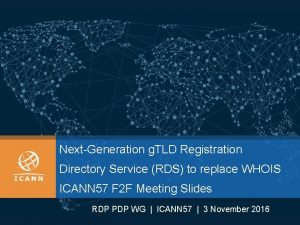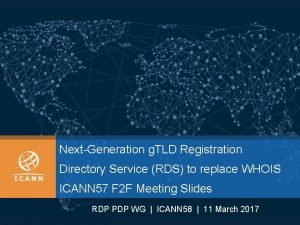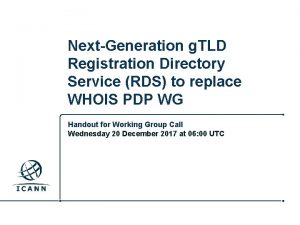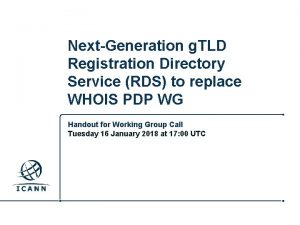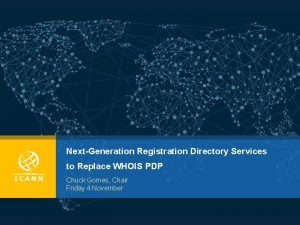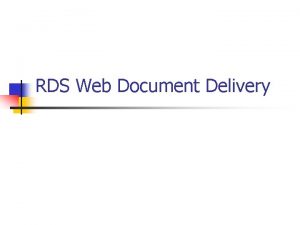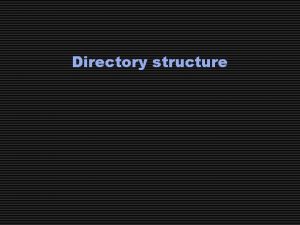Registration Directory Service RDS WHOIS Summary of Activities

















- Slides: 17

Registration Directory Service (RDS) WHOIS Summary of Activities 9 June 2017 |1

Activities in Advance of Board Consideration ICANN 55 (A) 56 (B) 57 (C) ICANN 58 (A) ICANN 59 (B) ICANN 60 (C) First meeting of PDP WG ICANN 61 (A) ICANN 62 (B) ICANN 63 (C) GNSO PDP ON A NEXT-GENERATION REGISTRATION DIRECTORY SERVICE Ongoing PDP activities Commencement of RDS review First meeting of review team Review team in place Q 1 Q 2 Q 3 Q 4 2016 RDS/WHOIS 2 REVIEW Ongoing review activities Jan Feb Mar Apr May Jun Jul Aug Sep Oct Nov Dec 2017 2018 |2

Community & Org Implementation Following Board Action CANN 55(A) 56 (B) public comment 57 (C) ICANN 58 (A) ICANN 59 (B) ICANN 61 (A) ICANN 62 (B) ICANN 60 (C) Ongoing discussion with community regarding implementation details ICANN 63 (C) RDAP CONTRACT REQUIREMENTS Staff work resumed CROSS-FIELD ADDRESS VALIDATION CONTRACT REQUIREMENTS TRANSLATION AND TRANSLITERATION OF CONTACT INFORMATION IMPLEMENTATION First IRT meeting Projected Policy effective date Draft implementation plan/framework distributed to IRT Projected public comment on proposed Privacy/Proxy Services Accreditation Program First IRT meeting GNSO Council confirmed new trigger is consistent with Policy Effective date of ICANN PROCEDURES FOR HANDLING WHOIS CONFLICTS WITH PRIVACY LAWS new trigger Close of public comment on Procedure changes Phase 1 (Syntactic Validation) Compliance issues notices Phase 2 Cycle 4 Report Phase 2 (Syntax and Operability Validation) - Cycle 2 Report Projected commencement of next review of procedures Phase 2 Cycle 5 Report Publish RFP for 3 rd Party Solution RFP Response Deadline Execute Vendor Phase 2 Cycle 3 Report Contract Q 1 Q 2 Q 3 Q 4 2016 PRIVACY/PROXY SERVICES ACCREDITATION IMPLEMENTATION WHOIS ACCURACY/GAC SAFEGUARD ADVICE ON WHOIS VERIFICATION AND CHECKS Publish Vendor Study’s Final Report Jan Feb Mar Apr May Jun Jul Aug Sep Oct Nov Dec 2017 2018 |3

Contracted Parties Implementation ICAN N 56 (B) 55 (A) 57 (C) ICANN 58 (A) ICANN 59 (B) ICANN 60 (C) Implementation by Registries and Registrars ICANN 61 (A) ICANN 62 (B) ICANN 63 (C) IMPLEMENTATION OF THICK WHOIS: CONSISTENT LABELING AND DISPLAY (CLD) Policy effective date IMPLEMENTATION OF THICK WHOIS: TRANSITION FROM THIN TO THICK WHOIS FOR. COM, . NET AND. JOBS Implementation by registries and registrars to enable submission of all new domain name registrations as Thick WHOIS by 1 May 2018 Implementation by registries and registrars to migrate all data required for Thick WHOIS services for existing domain names by 1 February 2019 Q 1 Q 2 Q 3 Q 4 2016 Jan Feb Mar Apr May Jun Jul Aug Sep Oct Nov Dec 2017 2018 |4

Appendix Background Overview |5

Background Overview Topics 1 2 3 GNSO PDP on a Next-Generation Registration Directory Service (RDS)/WHOIS 2 Review Registration Data Access Protocol (RDAP) Implementation 4 5 6 Across-Field Address Validation Translation and Transliteration of Contact Information Implementation Privacy/Proxy Services Accreditation Implementation |6

Background Overview Topics, Cont. 7 8 9 ICANN Procedures For Handling WHOIS Conflicts with Privacy Laws WHOIS Accuracy/GAC Safeguard Advice on WHOIS Verification and Checks Implementation of THICK WHOIS |7

GNSO PDP on a Next-Generation Registration Directory Service (RDS) Comprehensive WHOIS policy reform remains the source of long-running discussions within the ICANN as well as wider Internet community. In November 2012, the ICANN Board passed a resolution that led to the creation of an Expert Working Group, and in parallel launched a Board-initiated GNSO PDP that specifically called out the topics of purpose and accuracy: Purpose: However, who would be granted the right to access the data, under what circumstances, and by which means. Accuracy: There are many WHOIS data elements required by the Registry Agreement and the Registrar Accreditation Agreement. If only one of these data fields is incorrect, does that mean the WHOIS information inaccurate? How can accuracy of data be verified and/or measured, especially considering that if data is not accurate the purpose of gathering the data might be questionable in the first place. In June 2014, the Expert Working Group published its final report. Upon the publication, an informal group of GNSO Councilors and Board members collaborated to propose a Process Framework for structuring a GNSO PDP. In May 2015, the Board adopted the Process Framework and reaffirmed its 2012 request for a Board-initiated GNSO PDP to define the purpose of collecting, maintaining and providing access to g. TLD registration data, and to consider safeguards for protecting data, using the recommendations in the Expert Working Group’s final report as an input. |

GNSO PDP on a Next-Generation Registration Directory Service (RDS), Cont. The PDP Working Group will address: Users/purposes: Who should have access to g. TLD registration data and why (i. e. , for what purpose? ) Gated access: What steps should be taken to control data access for each user/purpose? Data accuracy: What steps should be taken to improve data accuracy? Data elements: What data should be collected, stored, and disclosed? Privacy: What steps are needed to protect data and privacy? Coexistence: What steps should be taken to enable next-generation RDS coexistence with and replacement of the legacy WHOIS system? Compliance: What steps are needed to enforce these policies? System Model: What system requirements must be satisfied by any next-generation RDS implementation? Cost: What costs will be incurred and how must they be covered? Benefits: What benefits will be achieved and how will they be measured? Risks: What risks do stakeholders face and how will they be reconciled? The PDP WG began its work in early 2016. As of May 2017, initial points of rough consensus have been reached on RDS users/purposes, data elements, privacy and access, all in a “thin data” context. |9

Registration Directory Service (RDS)/WHOIS 2 Review Per the ICANN Bylaws, the Board shall cause a periodic review (no less frequently than every five years) to assess the effectiveness of then current g. TLD RDS and whether its implementation meets the legitimate needs of law enforcement, promoting consumer trust and safeguarding registrant data. The first WHOIS Review presented its report and recommendations in 2012. The second review (RDS/WHOIS 2) commenced in October 2016 with the Call for Volunteers. 38 applications were submitted for appointment to the RDS/WHOIS 2 Review Team. The SOs/ACs Chairs have considered the nominations from the individual SO/ACs and have confirmed the review team members. ICANN announced the members of the review team on 2 June 2017. Community concerns were raised about the expected workload and community bandwidth in light of the many RDS/WHOIS related activities underway. In response to an action item resulting from a telephone conference between the SO/AC chairs and Board Working Group on 07 February 2017, ICANN Organization prepared a paper that is intended to offer guidance on the scope of the review for the RDS Review Team to consider as it determines its scope of work. , terms of reference and timeline. The Review Team will hold the kick-off call on 14 June 2017, and its first face-to-face meeting at ICANN 59. | 10

Registration Data Access Protocol (RDAP) Implementation RDAP history September 2011 – SSAC published SAC 051: “The ICANN community should evaluate and adopt a replacement domain name registration data access protocol. ” October 2011 – Board adopts SAC 051 June 2012 – Roadmap to implement SAC 051 published 2012 – RDAP community development within IETF WG began March 2015 – RDAP IETF RFCs published June 2015 – Began work on RDAP g. TLD Profile which maps RDAP features to existing policy and contract requirements July 2016 – Version 1. 0 of RDAP g. TLD Profile published August 2016 – Ry. SG submitted a Request for Reconsideration regarding inclusion of RDAP in the Consistent Labeling & Display policy, among other things February 2017 – Revised Consistent Labeling & Display policy, without RDAP, was published At ICANN 58, ICANN org held a session with the community with a proposed implementation of RDAP, including requirements from the Registry Agreement. At the May 2017 GDD Summit, the registries informed ICANN org that they will submit a proposal for a pilot implementation of RDAP to ICANN org for consideration. | 11

Across-Field Address Validation WHOIS Accuracy Program Specification of the 2013 Registrar Accreditation Agreement requires registrars to validate and verify defined data fields, such as phone number, email and postal address. Also required is the validation of the registrant’s postal address fields and confirm consistency across fields (e. g. , street exists in city, city exists in state/province, city matches postal code). These validation actions must be completed within fifteen (15) days of: The registration of a Registered Name sponsored by Registrar The transfer of the sponsorship of a Registered Name to Registrar any change in the Registered Name Holder with respect to any Registered Name sponsored by Registrar, Registrar will, with respect to WHOIS information and the corresponding customer account holder contact information related to such Registered Name. The 2013 Registrar Accreditation Agreement requires ICANN org to review these requirements in consultation with the Registrar WHOIS Validation Working Group to identify a set of tools that will enable accredited registrars to complete these validation actions. In 2014, ICANN and the Registrar Group agreed to place the Across Field Address Validation (AFAV) initiative on hold. Instead, ICANN focused on identifying commercially reasonable and global solutions to meet RAA requirements and presented the research results during ICANN 57. In January 2017, the WHOIS Validation Working Group was re-formed to focus its effort on identifying an appropriate set of tools to enable registrars to complete the Across Field Address Validation requirements. This effort involves creating a Request for Proposal (RFP) formulation with the intent of contracting with a third party and determine what, if any, commercial solutions exist in the marketplace that are deemed to be ‘technically and commercially viable’ based on the current RAA language. | 12

Translation and Transliteration of Contact Information Implementation Three of the final 16 recommendations from the first WHOIS Review Team, which the Board adopted, were: A working group should be formed to determine appropriate internationalized domain name registration data requirements and evaluate available solutions. The final data model, including any requirements for the translation or transliteration of the registration data, should be incorporated in the relevant Registrar and Registry Agreements. Metrics should be developed to maintain and measure the accuracy of the internationalized registration data and corresponding data in ASCII, with clearly defined compliance methods and targets. An Internationalized Registration Data Expert Work was formed to determine the requirements for internationalized registration data, and produce a data model that matches the requirements. The Expert Working Group had its first meeting in September 2013, and published its final report in September 2015. In June 2013, the GNSO initiated PDP on the Translation and Transliteration of Contact Information. The PDP Working Group published its final report in June 2015. As the PDP work occurred in parallel with the Expert Working Group’s work, the PDP Working Group tried to coordinate with the Expert Working Group as much as possible. The final PDP recommendations were determined to be consistent with the Expert Working Group’s recommendations. As of June 2017, the IRT has been engaged in discussions around language and script tags for data entered into registration directory services. The team is discussing the necessity of such tags, and how to gather data to provision language and script information for those tags should they be deemed a necessity in terms of implementing the T/T PDP WG’s recommendations. Discussions around the scope of the policy pertaining to these tags remains the subject of IRT meetings. | 13

Privacy/Proxy Services Accreditation Implementation The 2013 Registrar Accreditation Agreement (RAA) contemplates the development and implementation of a privacy and proxy service accreditation by ICANN. In October 2013, the GNSO Council initiated a PDP on issues relating to the accreditation of Privacy and Proxy services. In December 2015, the PDP Working Group published its final report. The GNSO Council approved the Working Group’s Final Recommendations in January 2016, and the Board adopted those recommendations in August 2016. The Implementation Review Team convened in October, 2016, and is pursuing an expedited timeline in light of the upcoming expiration of the 2013 RAA’s interim specification on privacy and proxy registrations (in January 2018). The IRT aims to have the draft Accreditation Policy, Accreditation Agreement and related materials ready to publish for public comment in September 2017. The ultimate effective date of this program’s new requirements will depend on the amount of IRT work required following the close of the public comment period. | 14

ICANN Procedures For Handling WHOIS Conflicts with Privacy Laws In December 2003, the WHOIS Task Force 2 of the GNSO recommended the development of a procedure to allow g. TLD registry/registrars to demonstrate when they are prevented by local laws from fully complying with the provisions of ICANN contracts regarding personal data in WHOIS. In November 2005, the GNSO concluded a PDP on establishing such a procedure. The ICANN Board adopted the policy in May 2006. In January 2008, the procedures went into effect and detail how ICANN will respond to a situation where a registrar/registry indicates that it is legally prevented by local/national privacy laws or regulations from complying with the provisions of its ICANN contract regarding the collection, display and distribution of personal data via WHOIS. Step 6 of the procedures requires ICANN to review the effectiveness of the procedures annually. In October 2014, ICANN published a call for volunteers for an Implementation Advisory Group to review the procedures. In May 2016, the Implementation Advisory Group published its final report and recommended a modification to the procedures. The modification would allow a party to trigger the procedure by obtaining a written statement from the government agency charged with enforcing its data privacy laws indicating that a particular WHOIS obligation conflicts with national law and then submitting that statement to ICANN, in addition to the existing trigger. In February 2017, the GNSO Council confirmed that the modification would not be inconsistent with the original GNSO policy recommendations, and recommended that ICANN org moves forward with modifying the procedures. The GNSO Council also requested that ICANN org commence the next review of the procedures no later than October 2017. On 3 May 2017, ICANN org published a staff paper on the procedures intended to launch the review of the procedures. The close of the public comment window has been extended to 7 July at the request of the GAC. The comments received via the ICANN public comment forum together with the comments of the DPAs that ICANN is separately soliciting will inform next steps of the review. | 15

WHOIS Accuracy/GAC Safeguard Advice on WHOIS Verification and Checks In May 2012, the first WHOIS Review Team published its final report, which included several recommendations on WHOIS data accuracy. The GAC has issued Advice on the topic of WHOIS data accuracy dating back to 2007. To implement the WHOIS Review Team’s recommendations and address GAC’s concerns on WHOIS accuracy, ICANN initiated the development of the WHOIS Accuracy Reporting System (ARS)—a framework for conducting repeatable assessments of WHOIS accuracy, publicly report the findings, and provide data to the ICANN Contractual Compliance team to follow up on potentially inaccurate records with registrars. ICANN organization chose to implement the ARS in a phased approach, with the phases based on three approaches to assessing accuracy of contact information as recommended by the SSAC in SSAC 058. Phase 1 analyzes the syntax accuracy of WHOIS contact information. The report was published in August 2015. Phase 2 is the ongoing and cyclical assessment of the operability of the contact data in the record by combining the syntax tests from Phase 1 with operability tests such as sending emails and placing calls. The first report was published in December 2015 and subsequent reports have been published each June & December since. Phase 3, if implemented would focus on attempting to validate the identity of the contact listed in the WHOIS. There are currently no plans for Phase 3 to be implemented by the ICANN organization. | 16

Implementation of THICK WHOIS ICANN specifies WHOIS requirements through the Registry Agreement (RA) and the Registrar Accreditation Agreement (RAA). Registries satisfy these obligations using different service models. Thin registries only maintain and provide the information associated with the domain name while registrars maintain and provide information associated with the registrant and contacts of the domain. Thick registries maintain and provide both sets of data. In March 2012, the GNSO initiated a PDP on thick WHOIS. In October 2013, the PDP Working Group published its final report and recommended that the provision of thick WHOIS, with a consistent labelling and display as per the model outlined in Specification 3 of the 2013 Registrar Accreditation Agreement, become a requirement for all g. TLD registries. The Board adopted the PDP recommendations in February 2014. In line with the PDP recommendations, ICANN and the Implementation Review Team identified two outcomes for the implementation: Consistent Labelling and Display of WHOIS output for all g. TLDS Transition from thin to thick for. COM, . NET, and JOBS, the remaining this registries | 17

